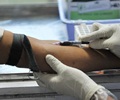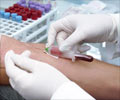Researchers at Scripps Florida have developed a method to disrupt the production of hepatitis C virion (HCV)—a significant human pathogen, infecting more than three percent of the world’s population—paving the way for development of new therapies.
Timothy Tellinghuisen, an assistant professor in the Department of Infectology at Scripps Florida, and his colleagues who used mutations of the viral NS5A phosphoprotein to disrupt virus particle production at an early stage of assembly developed the method.Since a long time, NS5A has been proposed as a regulator of events in the HCV life cycle, however, its actual mechanism was not known clearly.
“The interesting thing about this mutant is that while it triggers totally normal RNA replication, it causes severe defects in the output of infectious virus—in fact, it releases no infectious virus that we can detect. And though this discovery isn’t a cure for HCV, it is an important research tool that stops the assembly pathway.” Total disruption of the replication process would be a cure for the disease, he adds, and that’s the team’s long-term goal,” said Tellinghuisen.
HCV infection is pandemic in nature and is almost five to seven times more prevalent than HIV. HCV occurs when blood from an infected person enters the body of someone who is not infected. Most new HCV infections are due to illegal drug injections and sharing needles. But, those who had blood transfusions prior to blood donor screening in 1991, healthcare workers who had needle stick accidents, and hemodialysis patients are also at risk for developing HCV infection.
Mainly, the virus infects the liver, and following many decades of virus reproduction it leads to serious disease such as hepatitis (liver inflammation), cirrhosis (liver scarring), and carcinoma (liver cancer). Finally, HCV infection destroys the liver, resulting in death. Attempts at curing HCV infections with drug therapy have been only marginally successful.
The researchers focused on NS5A for understanding the regulation of events used by the virus to assemble infectious copies of itself and exit the cell. NS5A is a three-domain protein, i.e. it is comprised of three closely folded regions almost 50 to 300 amino acids in length. The requirement of domains I and II for RNA replication is well documented. However, NS5A domain III is not required for RNA replication, and the function of this region in the HCV life cycle is unknown.
Advertisement
“Those proteins assemble in the cell to make a structure called a replicase that then copies the viral RNAWe measured that RNA accumulation and observed no defect in RNA replication, but found, surprisingly, that no infectious viral particles were released from the cells,” explained Tellinghuisen.
Advertisement
Through genetic mapping and biochemical analyses it was shown that their deletion altered a phosphorylation signal controlling the switch from RNA replication to virus particle assembly. This signal was ascribed to the activity of a cellular kinase that when inhibited by genetic or chemical means led to a reduction in infectious virus production without altering HCV RNA replication.
“These data provide the first evidence for a function of domain III of NS5A and implicate NS5A as an important regulator of the RNA replication and virion assembly of HCV. The ability to uncouple virus production from RNA replication may be useful in understanding HCV assembly and may become therapeutically important,” said Tellinghuisen.
The study is published in the latest issue of the journal PLoS Pathogens.
Source-ANI
SPH/L











